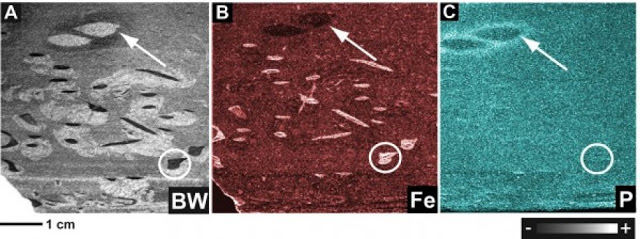
Research at the Department of Energy’s SLAC National Accelerator Laboratory reveals new details about how tiny, burrowing sea organisms can influence the chemistry and structure of rocks where hydrocarbon deposits such as oil and gas are found.
An international team of scientists used X-rays to image the chemistry of rock samples containing well-preserved 80-million-year-old fossilized burrows, which may have been made by millimeter-sized bristly worms known as polychaetes. They found that the worms appeared to concentrate some chemical elements in their burrows while depleting others.
The study, published online Oct. 7 in the journal Geology, provides new insight into how ancient sea worms interact with the sediment on the ocean bottom and control the composition and geochemical signature of rocks formed by that sediment, which today serve as markers for ancient climate patterns and oil and gas reservoirs.
The pioneering X-ray scanning method that researchers used at SLAC opens up new ways to study Earth’s distant environmental and geological past and supports research about the formation of hydrocarbon deposits.
While it’s only in its early stages, the research shows a lot of promise, said Dario Harazim, a petroleum geologist who led the study while working as instructor at Memorial University of Newfoundland in Canada. “We might need to rethink the processes of how certain elements are incorporated into the rock record — how they are preserved and how we use them to reconstruct the chemistry and other properties of the ancient ocean,” Harazim said.
“To date, the ancient ocean temperatures, oxygen levels and other factors important in rock formation have been considered major drivers controlling the accumulation of trace elements in the rock,” he said. “Here, we provide new insight into how burrowing organisms play a major role in controlling the trace amounts of some elements in rocks formed from sediment.”
While the sea worms like the ones that likely made these ancient burrows are still important in the modern environment, they are difficult to observe because they are embedded in the sticky mud of the sea floor. Removing worms and their surrounding mud to a more convenient location for study would disrupt their relationship with their natural environment and might not yield trustworthy results.
From Dino Birds to Burrowing Worms
Harazim partnered with a research group based at University of Manchester to study exceptionally preserved rock samples from Baja California in Mexico. The Manchester group had worked with SLAC distinguished staff scientist Uwe Bergmann to develop a fast X-ray scanning technique for studying fossils at SLAC’s Stanford Synchrotron Radiation Lightsource (SSRL), a DOE Office of Science User Facility. The technique has been used to study chemical traces of feathers and tissues in a famous fossil link between birds and dinosaurs.
Unlike many conventional techniques, the unique fast-scanning technique at SSRL is non-destructive, so it preserved the features and localized chemistry of the worm burrows. It can also image large sample surfaces of up to tens of square centimeters.
“The large-scale imaging capabilities at SSRL permitted the precise mapping of very small chemical concentrations associated with these organisms’ interaction with their environment,” said Phillip Manning, a University of Manchester paleontologist who helped to pioneer the technique. “This latest collaboration between accelerator physics and paleontology has once again resurrected chemical ghosts that shed new light on key scientific questions.”
The study shows how a unique and sophisticated feeding strategy allows the sea worms to separate sediment particles of different sizes, Harazim said: “They consume mineral particles, clay and bacteria that live on the mineral surfaces. As this mix passes through their chemically aggressive gut, this material is getting broken down and degraded.”
The way the worms redistribute and digest these grains, and how they control the concentration of some elements, is still not well understood. Their feeding creates pockets of porous sediment that can potentially fill over time with concentrations of mineral cement, organic material and potentially even hydrocarbons.
The researchers, who verified the SSRL results with those obtained from other conventional methods, found that certain elements, including strontium and barium, are depleted from all areas of the rock. These elements were likely either being absorbed into the worms’ bodies or released to the surrounding waters.
Applications in Ancient Climate, Ocean Chemistry Studies
Further research may lead to a better understanding of how analyzing the chemical signature of these burrowing organisms may relate to ancient climate patterns and changes in ocean chemistry, Harazim said. “This technique allows you to study how the activity of burrowing organisms can influence the chemistry and composition of the rock they are living in. It helps us to better understand the geological record and helps us to read Earth’s geological past in a more sophisticated way,” he said.
He said there are plans for follow-up research with different types of fossilized samples to see if there are commonalities in their chemical concentration and distribution.
“There is still a lot to learn about how these organisms impact the porosity and geochemical composition of rocks, and how loose sediment becomes rock,” he said.
The work was supported by the American Association of Petroleum Geologists, the International Association of Sedimentologists, the Society for Sedimentary Geology, the Geological Society of America, the Natural Sciences and Engineering Research Council of Canada, and the Science and Technology Facilities Council.
Reference:
Dario Harazim, Duncan McIlroy, Nicholas P. Edwards, Roy A. Wogelius, Phillip L. Manning, Kristin M. Poduska, Graham D. Layne, Dimosthenis Sokaras, Roberto Alonso-Mori, Uwe Bergmann. Bioturbating animals control the mobility of redox-sensitive trace elements in organic-rich mudstone. Geology, 2015; G37025.1 DOI: 10.1130/G37025.1
Note: The above post is reprinted from materials provided by SLAC National Accelerator Laboratory.










